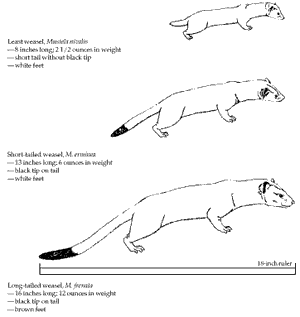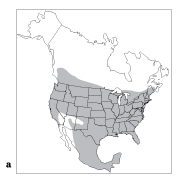Weasels | Weasel Overview | Weasel Damage Assessment | Weasel Damage Management | Weasel Acknowledgments | Weasel Resources | ICWDM | Wildlife Species Information
Identification
Weasels belong to the Mustelidae family, which also includes mink, martens, fishers, wolverines, badgers, river otters, black-footed ferrets, and four species of skunks. Although members of the weasel family vary in size and color (Fig. 1), they usually have long, slender bodies, short legs, rounded ears, and anal scent glands.
A weasel’s hind legs are barely more than half as long as its body (base of head to base of tail). The weasel’s forelegs also are notably short. These short legs on a long, slender body may account for the long-tailed weasel’s (Mustela frenata) distinctive running gait. At every bound the long body loops upward, reminding one of an inch-worm.
In the typical bounding gait of the weasel, the hind feet register almost, if not exactly, in the front foot impressions, with the right front foot and hind feet lagging slightly behind. The stride distance normally is about 10 inches (25 cm).
Male weasels are distinctly larger than females. The long-tailed and short-tailed (M. erminea) weasels have a black tip on their tails, while the least weasel (M. nivalis) lacks the black tip
Figure 1. Least weasel, Mustela nivalis (left); Shorttailed weasel, M. erminea, in summer coat (middle); Short-tailed weasel in winter coat (right).
General Biology, Reproduction, and Behavior
Weasels are active in both winter and summer; they do not hibernate. Weasels are commonly thought to be nocturnal but evidence indicates they are more diurnal in summer than in winter.
Home range sizes vary with habitat, population density, season, sex, food availability, and species (Svendsen 1982). The least weasel has the smallest home range. Males use 17 to 37 acres (7 to 15 ha), females 3 to 10 acres (1 to 4 ha). The short-tailed weasel is larger than the least weasel and has a larger home range. Male short-tailed weasels use an average of 84 acres (34 ha), and females 18 acres (7 ha), according to snow tracking.
The long-tailed weasel has a home range of 30 to 40 acres (12 to 16 ha), and males have larger home ranges in summer than do females. The weasels appear to prefer hunting certain coverts with noticeable regularity but rarely cruise the same area on two consecutive nights.
Weasel population densities vary with season, food availability, and species. In favorable habitat, maximum densities of the least weasel may reach 65 per square mile (169/km2); the short-tailed weasel, 21 per square mile (54/km2); and the long-tailed weasel, 16 to 18 per square mile (40 to 47/km2). Population densities fluctuate considerably with year-to-year changes in small mammal abundance, and densities differ greatly among habitats. Weasels, like all mustelids, produce a pungent odor. When irritated, they discharge the odor, which can be detected at some distance (Jackson 1961).
Long-tailed weasels mate in late summer, mostly from July through August. Females are induced ovulators and will remain in heat for several weeks if they are not bred. There is a long delay in the implantation of the blastocyst in the uterus, and the young are born the following spring, after a gestation period averaging 280 days. Average litters consist of 6 young, but litters may include up to 9 young. The young are blind at birth and their eyes open in about 5 weeks. They mature rapidly and at 3 months of age the females are fully grown. Young females may become sexually mature in the summer of their birth year.
Habitat
Some authors report finding weasels only in places with abundant water, although small rodents, suitable as food, were more abundant in surrounding habitat. Weasels are commonly found along roadsides and around farm buildings. The absence of water to drink is thought to be a limiting factor (Henderson and Stardom 1983).
A typical den has two surface openings about 2 feet (61 cm) apart over a burrow that is 3 to 10 feet (0.9 to 3 m) long. Other weasel dens have been found in the trunk of an old uprooted oak, in a bag of feathers, in a threshing machine, in the trunk of a hollow tree, in an old mole run, a gopher burrow, and a prairie dog burrow (Henderson and Stardom 1983).
(Fig. 2) The long-tailed weasel sometimes is as long as 24 inches (61 cm). The short-tailed weasel is considerably smaller, rarely longer than 13 inches (33 cm) and usually weighing between 3 and 6 ounces (87 and 168 g). Just as its common name implies, the least weasel is the smallest, measuring only 7 or 8 inches (18 to 20 cm) long and weighing 1 to 2 1/2 ounces (28 to 70 g). Many people assume the least weasel is a baby weasel since it is so small.
Weasels | Weasel Overview | Weasel Damage Assessment | Weasel Damage Management | Weasel Acknowledgments | Weasel Resources | ICWDM | Wildlife Species Information
Range
Figure 3. Range of the (a) long-tailed weasel, (b) short-tailed weasel, and (c) least weasel in North America.
Three species of weasels live in North America. The most abundant and widespread is the long-tailed weasel. Some that occur in parts of Kansas, Oklahoma, Texas, and New Mexico have a dark “mask” and are often called bridled weasels. The short-tailed weasel occurs in Canada, Alaska, and the northeastern, Great Lakes, and northwestern states, while the least weasel occurs in Canada, Alaska, and the northeastern and Great Lakes states (Fig. 3)
Food Habits
The weasel family belongs to the order Carnivora. With the exception of the river otter, all members of the weasel family feed primarily on insects and small rodents (Fig. 4). Their diet consists of whatever meat they can obtain and may include birds and bird eggs.
As predators, they play an important role in the ecosystem. Predators tend to hunt the most abundant prey, turning to another species if the numbers of the first prey become scarce. In this way, they seldom endanger the long-term welfare of the animal populations they prey upon.
Long-tailed weasels typically prey on one species that is continually available. The size of the prey population varies from year to year and from season to season. At times, weasels will kill many more individuals of a prey species than they can immediately eat. Ordinarily, they store the surplus for future consumption, much the same as squirrels gather and store nuts.
Pocket gophers are the primary prey of long-tailed weasels. In some regions these gophers are regarded as nuisances because they eat alfalfa plants in irrigated meadows and native plants in mountain meadows where livestock graze. Because of its predation on pocket gophers and other rodents, the long-tailed weasel is sometimes referred to as the farmer’s best friend. This statement, however, is an oversimplification of a biological relationship.
Weasels prefer a constant supply of drinking water. The long-tailed weasel drinks up to 0.85 fluid ounces (26 ml) daily.






